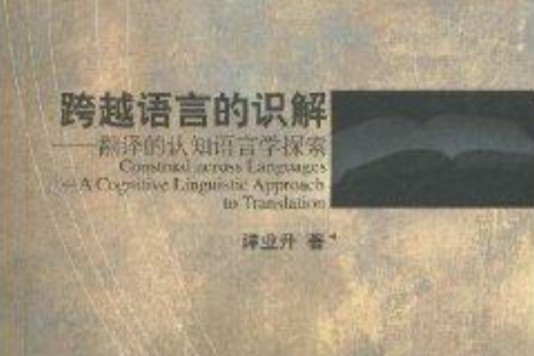《跨越語言的識解:翻譯的認知語言學探索》是以認知語言學為視角對翻譯現象進行的一項系統研究。它吸收了關聯翻譯論和翻譯圖示研究的成果,結合認知語言學的基本理論假設,創建了翻譯中意義建構的認知模式。《跨越語言的識解:翻譯的認知語言學探索》以“識解”作為文本對比分析的中介概念,刻畫了具體翻譯中涉及的多樣化認知運作,並對若干翻譯案例在系統描述的基礎上結合三個認知原則進行了解釋,模擬了翻譯認知文本分析的框架。《跨越語言的識解:翻譯的認知語言學探索》內容豐富,例證翔實,對從事翻譯教學和研究的教師、研究人員以及相關專業研究生都具有參考價值。
基本介紹
- 中文名:跨越語言的識解:翻譯的認知語言學探索
- 作者:譚業升
- 出版社:上海外語教育出版社
- 出版時間:2009年8月1日
- 頁數:222 頁
- 開本:32 開
- ISBN:7544613712, 9787544613712
- 語種:簡體中文
內容簡介,圖書目錄,序言,
內容簡介
《跨越語言的識解:翻譯的認知語言學探索》:搭建學術交流平台,傳播最新研究成果,學術理論新穎,研究領域廣寬,材料客觀翔實,論述周密嚴謹,文字簡潔流暢。
圖書目錄
Chapter 1 Introduction and Overview
Chapter 2 Toward a Cognitive Model of Meaning Construction in Translation
2.1 Introduction
2.2 Two Cognitive Constructivist Approaches to Translation
2.2.1 The Relevance theory of translation
2.2.2 A Schema-theoretic view of translation
2.2.3 Correlation between the Relevance theory of translation and the Schema-theoretic view of translation
2.2.4 An explanatory frame: Three cognitive principles governing translation in a sequence of priority
2.3 A Cognitive Linguistic View of Meaning Construction and Translation
2.3.1 What is cognitive linguistics?
2.3.2 The interaction between language and cognition in meaning construction in translation
2.3.3 Language schemata redefined and the sanctioning effects of linguistic conventions in translation
2.3.4 On-line construal in language use and translation
2.4 A Cognitive Model of Meaning Construction in Translation
Chapter 3 Domain Conceptualization and Ground Construal in Translation
3.1 Domain Conceptualization and Ground Construal
3.1.1 Cognitive domains
3.1.2 Ground
3.2 Construal and Cognitive Abilities
3.3 Image Transformation/Construal Shifis in Meaning Construction and the Implications for Translation
3.4 The Methodology of Investigating Translational Shifts and Variations
3.4.1 Descriptive Translation Studies vs.Prescriptive Translation Studies
3.4.2 Comparative analytical method of the DTS
3.5 Translational Shifts and Variations along Different Dimensions of Construal
3.5.1 Base/profile organization
3.5.2 Level of specificity (abstraction)
3.5.3 Subjectivity vs.objectivity
3.5.4 Perspective
3.5.5 Prominence: figure/ground organization
3.5.6 Interaction between different construal operations
3.6 Summary
Chapter 4 Image Schematic, Metonymic and Metaphorical Construal in Translation
4.1 Image Schema and Image Schematic Transformations in Translation
4.2 Metonymic Construal in Translation
4.2.1 A traditional view ofmetonymy and metonymy translation
4.2.2 Metonymy in cognitive linguistics and in translation
4. 2. 3 Interim summary
4. 3 Metaphorical Construal in Translation
4. 3.1 A brief review of metaphor translation study in the past
4. 3. 2 A cognitive linguistic view of metaphor and metaphor
translation
Case study I: Strategies of emotional metaphor translation
Case study 2: The systematic use of heart metaphors in Scarlet Letter
and its Chinese translation
4. 4 Summary
Chapter 5 Language Schemata, Preferred Construal Patterns, and Cognitive Changes in Translation
5. 1 Language Schemata and Preferred Construal Pattems
5. 2 Image-Schema-Based Preferred Construal Patterns
5. 3 Figure/Ground Construal and Animacy
5. 4 The Sanctioning Effects of Preferred Construal Patterns in Translation
Chapter 6 Cognitive Styles of Translation
6. 1 Introduction: A Formula of Cognitive Style
6. 2 The Coherence of Construal Operations in Fu Donghua's Translation of Gone with the Wind
6. 3 Metaphorical Coherence in Tess of the D'Urbervilles and Its Translation
6. 4 The Cognitive Styles of Pound and Yip's Chinese Poetry Translation
6. 4. 1 A critical review on the syntactic analysis of classical Chinese poetry and its translation
6. 4. 2 Pound and Yip's aesthetics of Chinese poetry and its translation
6. 4. 3 The correlation between Pound and Yip's aesthetic principles and construal operations
6. 4. 4 The preferred construal configuration of Chinese poetics and Pound and Yip's cognitive styles of Chinese poetry translation
6. 4. 5 The transplanting issue
6. 5 Conclusion
Chapter 7 Conclusion
7. 1 Major Findings.
7. 2 Limitations and Directions for Future Study
Bibliography
Appendix: A glossary in English and Chinese
序言
該書是以認知語言學為視角對翻譯現象進行的一項系統研究。
從2000年起我就對翻譯的認知語言學研究產生了興趣,並撰寫了《從語義認知的角度看翻譯技巧》一文,投給了一家學術期刊,很快就收到了該雜誌的錄用通知。記得在當時的國內學界,翻譯的文化、文學研究逐漸式強,而翻譯的語言學研究經過十餘年的風光逐漸式微。該學術刊物的肯定和鼓勵給了我這個從攻讀碩士學位起就一直專注於語言學和翻譯學結合研究的學子很大的鼓舞。
其時,認知語言學研究正逐漸在國內外語學界興起。2001年,《外國語》編輯部發起並主辦了第一屆全國認知語言學研討會(至今已經舉辦了五屆),一批年輕學者也正致力於介紹認知語言學的相關著述,並積極推動認知語言學研究在中國的發展。據我了解,復旦大學的博士生是當時最積極活躍的群體之一。同年,我非常幸運地考取了復旦大學,並師從熊學亮先生攻讀博士學位。

